Performance Prediction of Erosive Wear of Steel for Two-Phase Flow in an Inverse U-Bend
Abstract
:1. Introduction
2. Problem Description
2.1. Model Geometry
2.2. Carrier and Solid Phase Model
2.3. Erosion and Turbulence Model
2.4. Mesh and Model Validation
3. Results and Discussion
3.1. Effects of the Flow Velocity on Erosion
3.2. Effect of Sand Size on Erosion
4. Conclusions
- Erosive wear is the maximum at the outer curvature of the 180° U-bend and double offset U-bend for all evaluated cases. The maximum erosion area occurs between curvature angles of 150° and 180°. Additionally, the double offset U-bend proves its worth, as the highest wear rate is 1.23 times less than that of the 180° U-bend in the worst-case scenario.
- The erosion rate of the double offset U-bend was nearly 8.58 times less than 180° U-bend for the fluid velocity of 2 m/s and 1.82 times less for 4 m/s fluid velocities. The maximum erosion rate of double offset U-bend was reduced by 120% compared to the 180° U-bend for 6 m/s in liquid-solid flow.
- The 180° U-bend can be replaced with a double offset U-bend to slow down pipe erosion, especially for inverse orientation. Since many hydrocarbon and mineral processing plants require sand particle transportation, the double offset U-bend elbow appears to be a worthwhile alternative.
- The formation of an erosive wear pattern at the double offset U-bend and 180° U-bend is explained through the sand particle tracking. With the change of configuration from the 180° U-bend to the double offset U-bend, the effect of turbulence on the motion of sand decreases as the flow approaches downstream and results in less erosive wear in the double offset U-bend.
Author Contributions
Funding
Institutional Review Board Statement
Informed Consent Statement
Data Availability Statement
Acknowledgments
Conflicts of Interest
References
- Khan, R.; Ya, H.; Pao, W.; bin Abdullah, M.Z.; Dzubir, F.A. Influence of Sand Fines Transport Velocity on Erosion-Corrosion Phenomena of Carbon Steel 90-Degree Elbow. Metals 2020, 10, 626. [Google Scholar] [CrossRef]
- Ma, G.; Ma, H.; Sun, Z. Simulation of Two-Phase Flow of Shotcrete in a Bent Pipe Based on a CFD–DEM Coupling Model. Appl. Sci. 2022, 12, 3530. [Google Scholar] [CrossRef]
- Jia, W.; Zhang, Y.; Li, C.; Luo, P.; Song, X.; Wang, Y.; Hu, X. Experimental and numerical simulation of erosion-corrosion of 90° steel elbow in shale gas pipeline. J. Nat. Gas Sci. Eng. 2021, 89, 103871. [Google Scholar] [CrossRef]
- Bilal, F.S.; Sedrez, T.A.; Shirazi, S.A. Experimental and CFD investigations of 45 and 90 degrees bends and various elbow curvature radii effects on solid particle erosion. Wear 2021, 476, 203646. [Google Scholar] [CrossRef]
- Adedeji, O.E.; Duarte, C.A.R. Prediction of thickness loss in a standard 90° elbow using erosion-coupled dynamic mesh. Wear 2020, 460–461, 203400. [Google Scholar] [CrossRef]
- Khan, R. Numerical Investigation of the Influence of Sand Particle Concentration on Long Radius Elbow Erosion for Liquid-Solid Flow. Int. J. Eng. 2019, 32, 1485–1490. [Google Scholar] [CrossRef]
- Kannojiya, V.; Deshwal, M.; Deshwal, D. Numerical Analysis of Solid Particle Erosion in Pipe Elbow. Mater. Today Proc. 2018, 5 Pt 1, 5021–5030. [Google Scholar] [CrossRef]
- Florio, L.A. Estimation of particle impact based erosion using a coupled direct particle—Compressible gas computational fluid dynamics model. Powder Technol. 2017, 305, 625–651. [Google Scholar] [CrossRef]
- Duarte, C.A.R.; de Souza, F.J. Innovative pipe wall design to mitigate elbow erosion: A CFD analysis. Wear 2017, 380–381, 176–190. [Google Scholar] [CrossRef]
- Khan, R.; Ya, H.H.; Pao, W.; Khan, A. Erosion–Corrosion of 30°, 60°, and 90° Carbon Steel Elbows in a Multiphase Flow Containing Sand Particles. Materials 2019, 12, 3898. [Google Scholar] [CrossRef]
- Elemuren, R.; Tamsaki, A.; Evitts, R.; Oguocha, I.N.A.; Kennell, G.; Gerspacher, R.; Odeshi, A. Erosion-corrosion of 90° AISI 1018 steel elbows in potash slurry: Effect of particle concentration on surface roughness. Wear 2019, 430–431, 37–49. [Google Scholar] [CrossRef]
- Zhao, X.; Cao, X.; Xie, Z.; Cao, H.; Wu, C.; Bian, J. Numerical study on the particle erosion of elbows mounted in series in the gas-solid flow. J. Nat. Gas Sci. Eng. 2022, 99, 104423. [Google Scholar] [CrossRef]
- Wang, Q.; Ba, X.; Huang, Q.; Wang, N.; Wen, Y.; Zhang, Z.; Sun, X.; Yang, L.; Zhang, J. Modeling erosion process in elbows of petroleum pipelines using large eddy simulation. J. Pet. Sci. Eng. 2022, 211, 110216. [Google Scholar] [CrossRef]
- Wang, K.; Li, X.; Wang, Y.; He, R. Numerical investigation of the erosion behavior in elbows of petroleum pipelines. Powder Technol. 2017, 314, 490–499. [Google Scholar] [CrossRef]
- Khan, R.; Ya, H.H.; Shah, I.; Niazi, U.M.; Ahmed, B.A.; Irfan, M.; Glowacz, A.; Pilch, Z.; Brumercik, F.; Azeem, M.; et al. Influence of Elbow Angle on Erosion-Corrosion of 1018 Steel for Gas–Liquid–Solid Three Phase Flow. Materials 2022, 15, 3721. [Google Scholar] [CrossRef] [PubMed]
- Duarte, C.A.R.; de Souza, F.J.; dos Santos, V.F. Numerical investigation of mass loading effects on elbow erosion. Powder Technol. 2015, 283, 593–606. [Google Scholar] [CrossRef]
- Karimi, S.; Shirazi, S.A.; McLaury, B.S. Predicting fine particle erosion utilizing computational fluid dynamics. Wear 2017, 376–377, 1130–1137. [Google Scholar] [CrossRef]
- Cui, B.; Chen, P.; Zhao, Y. Numerical simulation of particle erosion in the vertical-upward-horizontal elbow under multiphase bubble flow. Powder Technol. 2022, 404, 117437. [Google Scholar] [CrossRef]
- Li, B.; Zeng, M.; Wang, Q. Numerical Simulation of Erosion Wear for Continuous Elbows in Different Directions. Energies 2022, 15, 1901. [Google Scholar] [CrossRef]
- Zhu, H.; Qi, Y. Numerical investigation of flow erosion of sand-laden oil flow in a U-bend. Process Saf. Environ. Prot. 2019, 131, 16–27. [Google Scholar] [CrossRef]
- Mazumder, Q.H. S-bend erosion in particulated multiphase flow with air and sand. J. Comput. Multiph. Flows 2016, 8, 157–166. [Google Scholar] [CrossRef]
- Gnanavelu, A.; Kapur, N.; Neville, A.; Flores, J.F. An integrated methodology for predicting material wear rates due to erosion. Wear 2009, 267, 1935–1944. [Google Scholar] [CrossRef]
- Mansouri, A.; Arabnejad, H.; Karimi, S.; Shirazi, S.A.; McLaury, B.S. Improved CFD modeling and validation of erosion damage due to fine sand particles. Wear 2015, 338–339, 339–350. [Google Scholar] [CrossRef]
- Chochua, G.G.; Shirazi, S.A. A combined CFD-experimental study of erosion wear life prediction for non-Newtonian viscous slurries. Wear 2019, 426–427, 481–490. [Google Scholar] [CrossRef]
- Pei, J.; Lui, A.; Zhang, Q.; Xiong, T.; Jiang, P.; Wei, W. Numerical investigation of the maximum erosion zone in elbows for liquid-particle flow. Powder Technol. 2018, 333, 47–59. [Google Scholar] [CrossRef]
- Wee, S.K.; Yap, Y.J. CFD study of sand erosion in pipeline. J. Pet. Sci. Eng. 2019, 176, 269–278. [Google Scholar] [CrossRef]
- Peng, W.; Cao, X. Numerical simulation of solid particle erosion in pipe bends for liquid–solid flow. Powder Technol. 2016, 294, 266–279. [Google Scholar] [CrossRef]
- Grant, G.; Tabakoff, W. Erosion Prediction in Turbomachinery Resulting from Environmental Solid Particles. J. Aircr. 1975, 12, 471–478. [Google Scholar] [CrossRef]
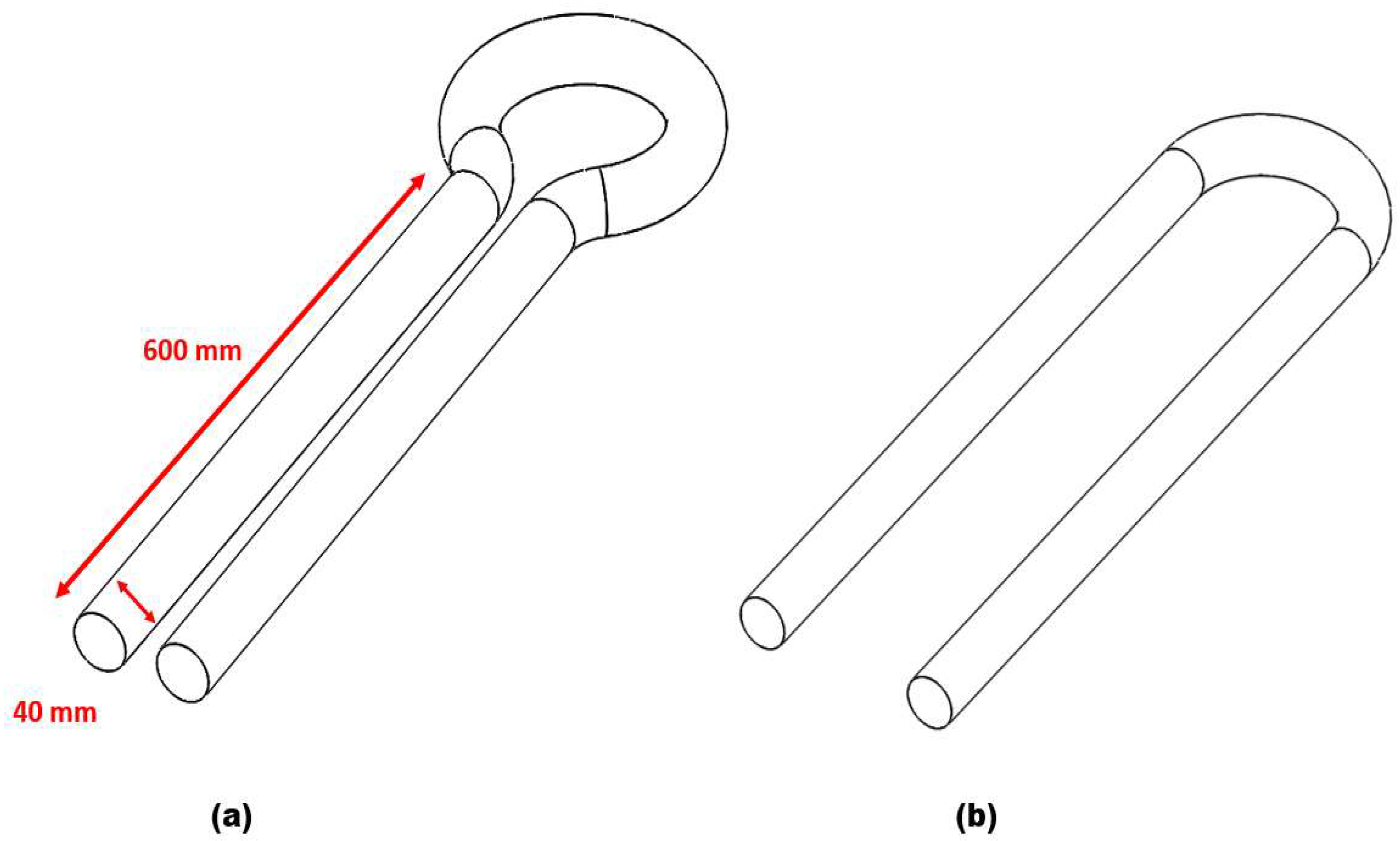
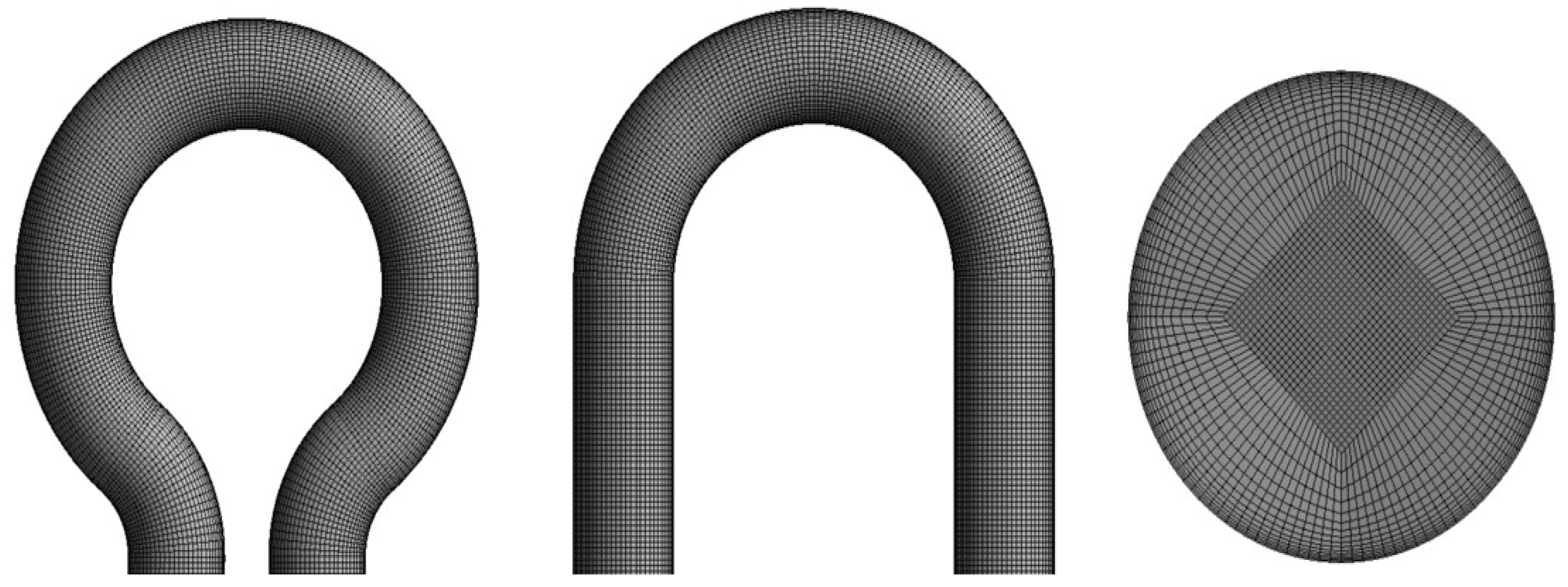
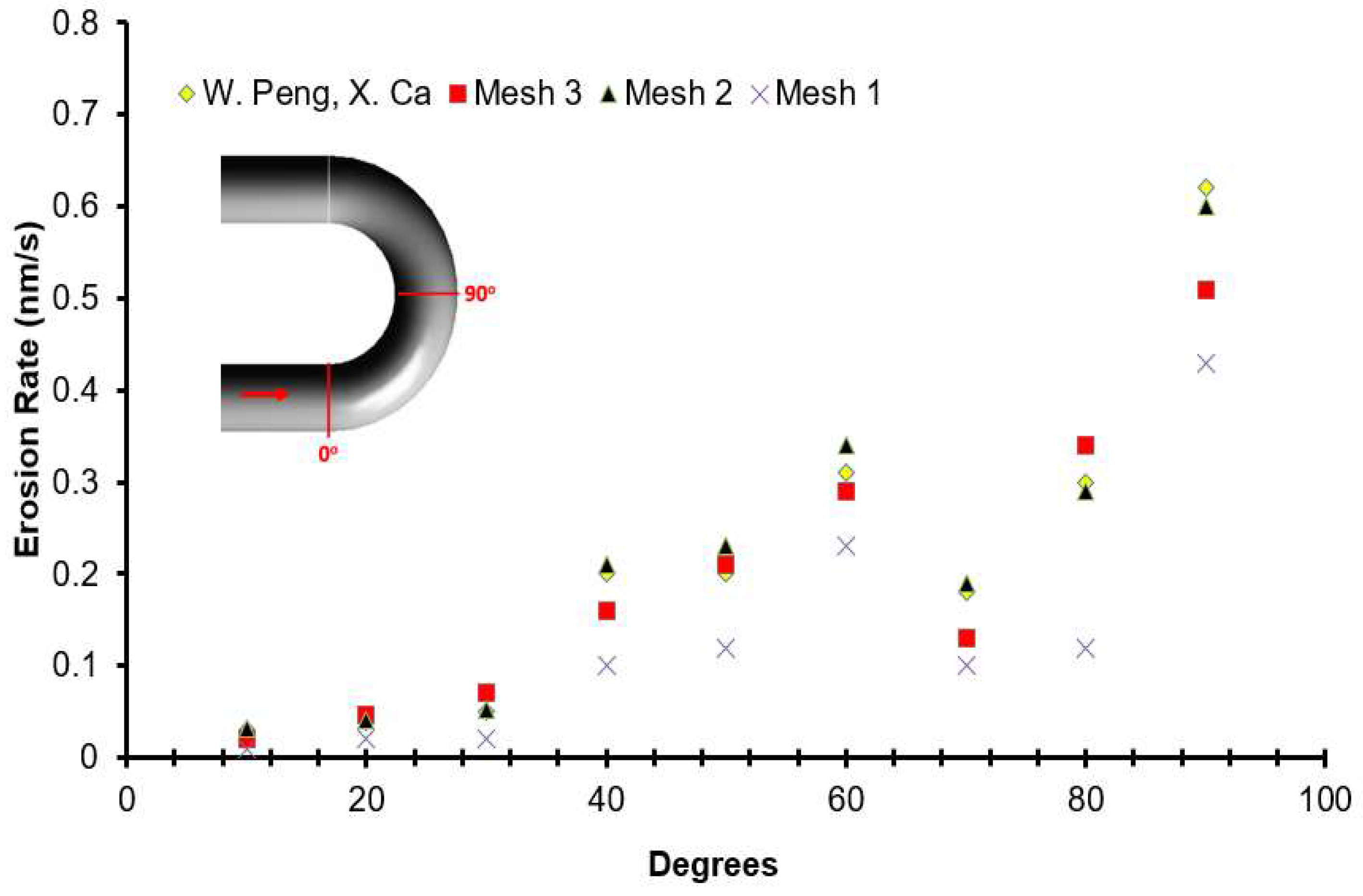
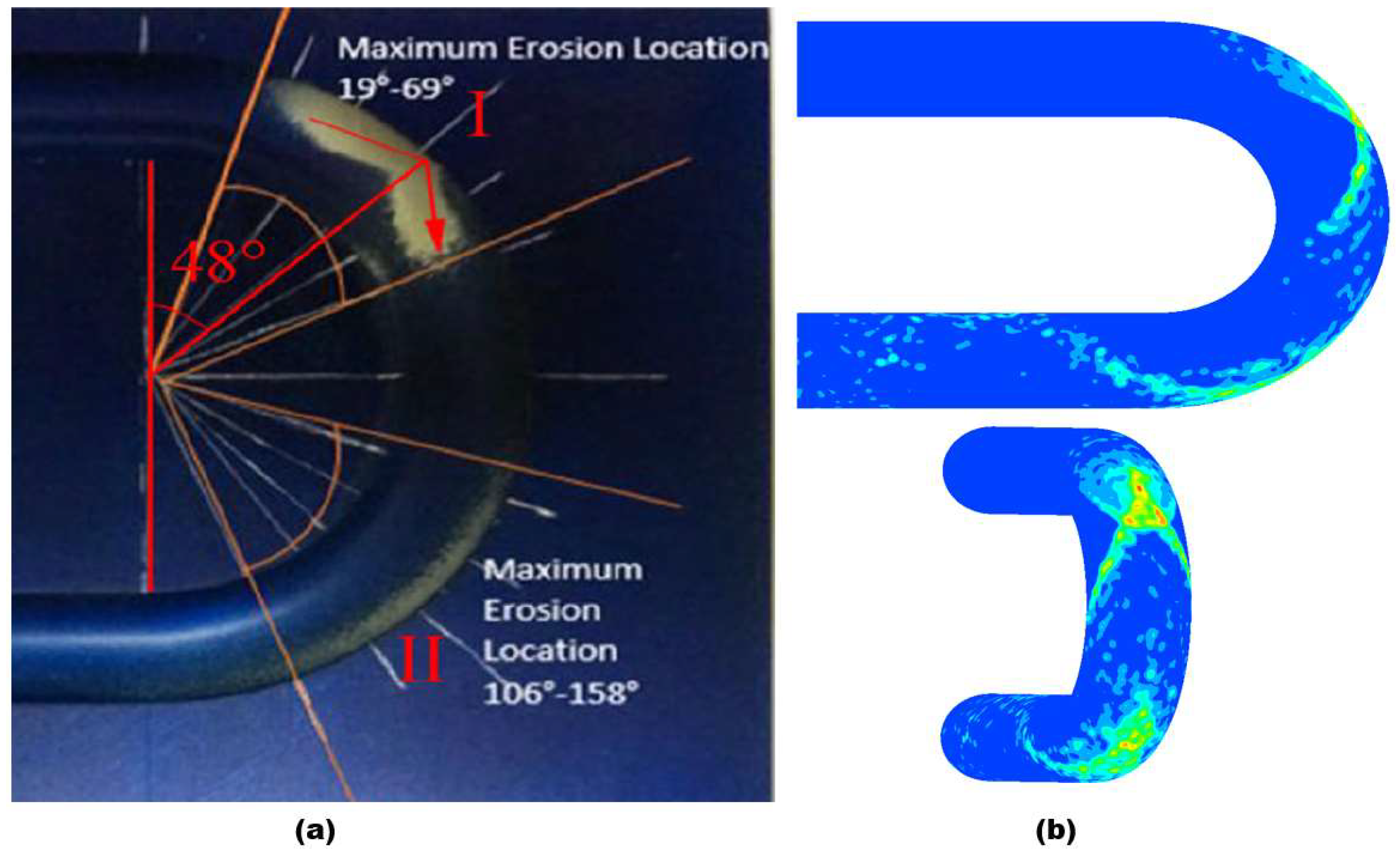
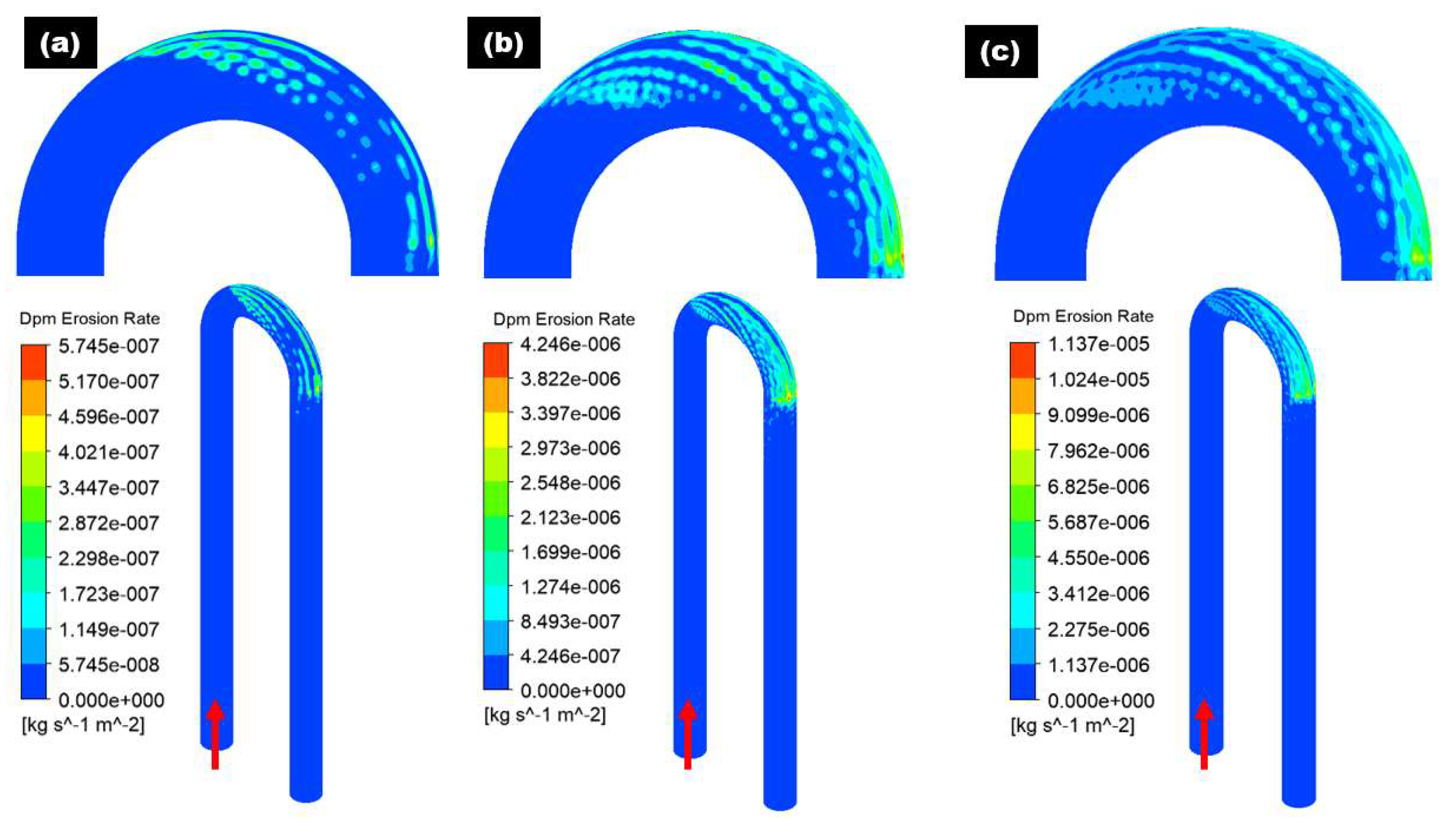
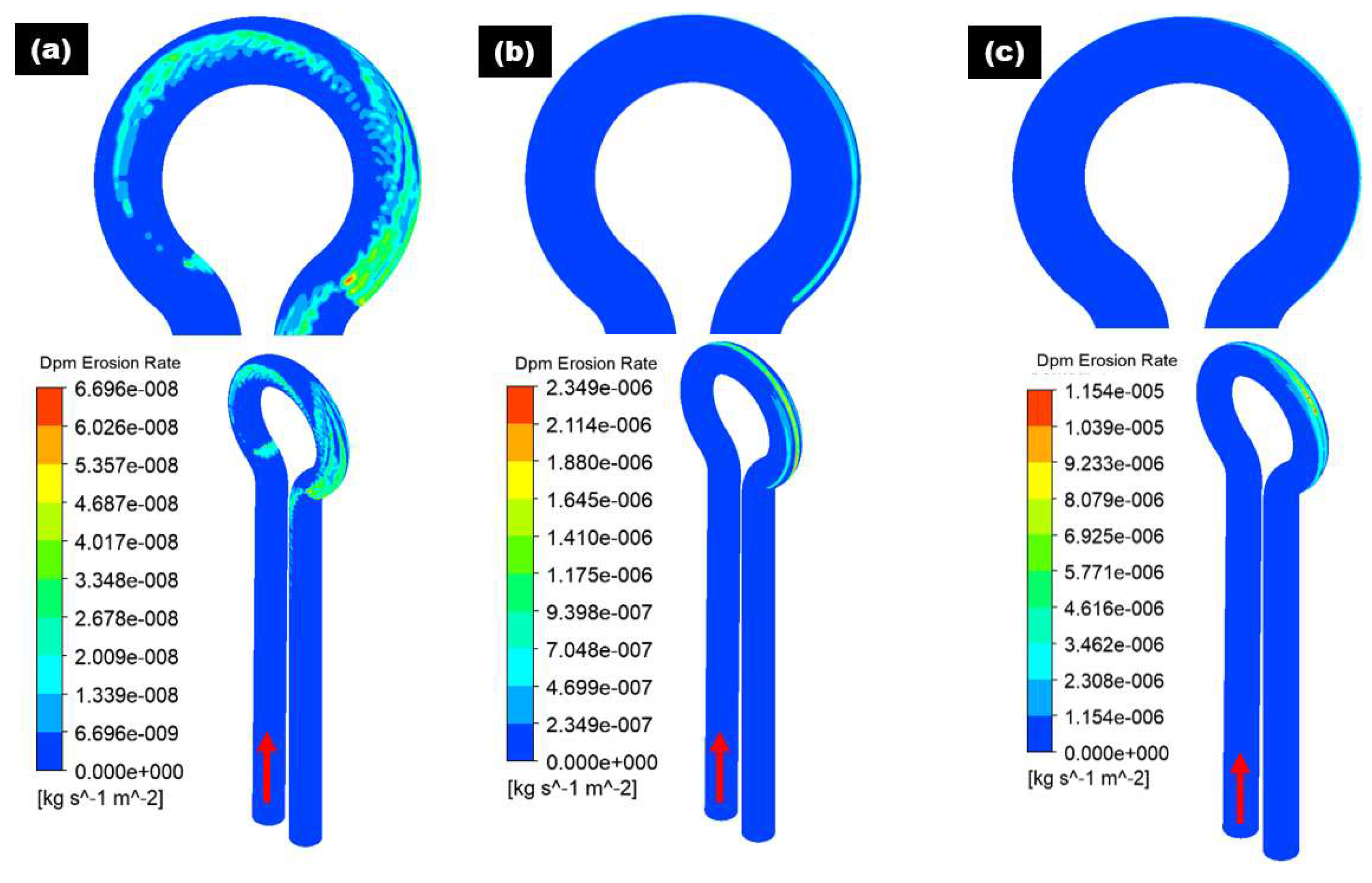
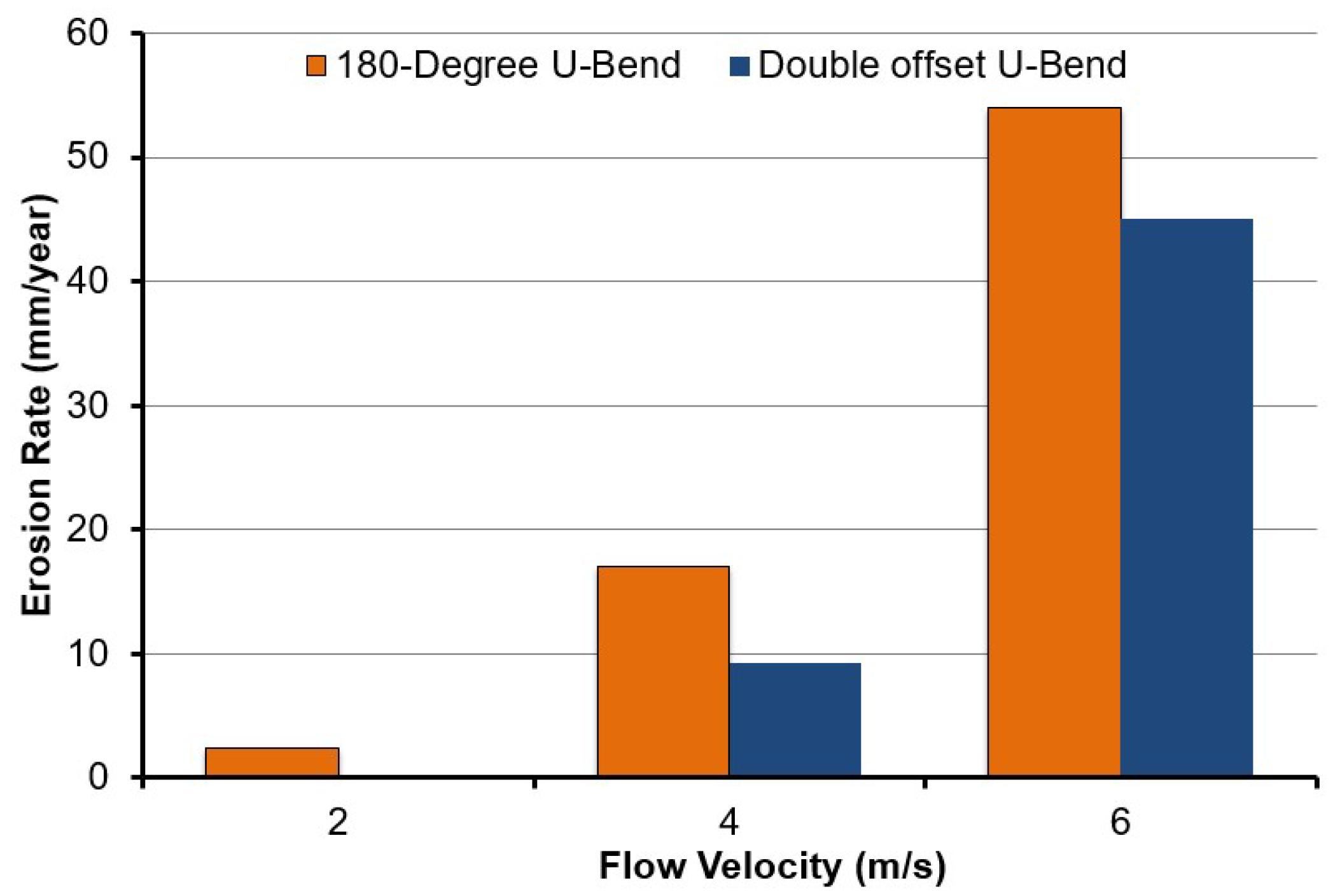


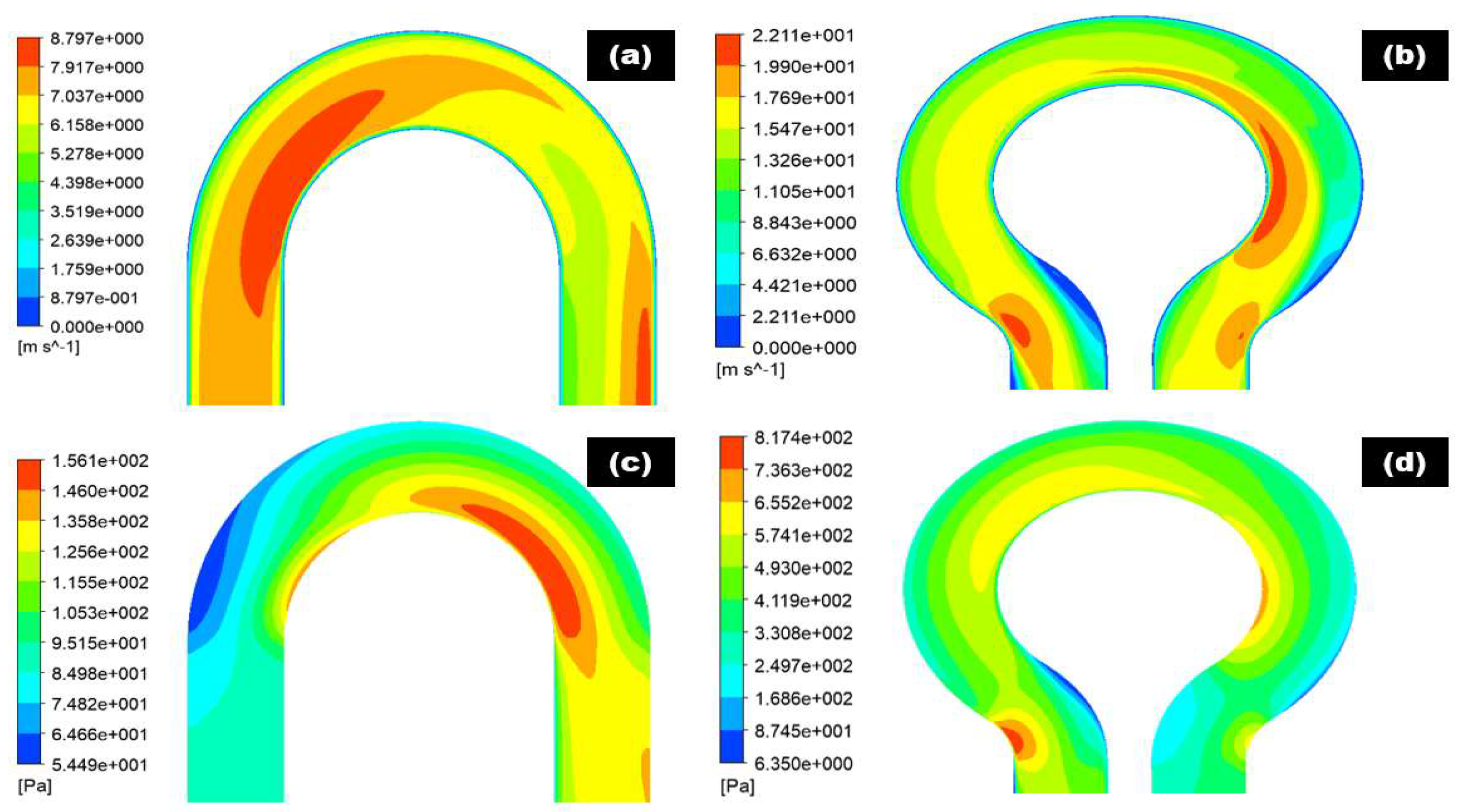


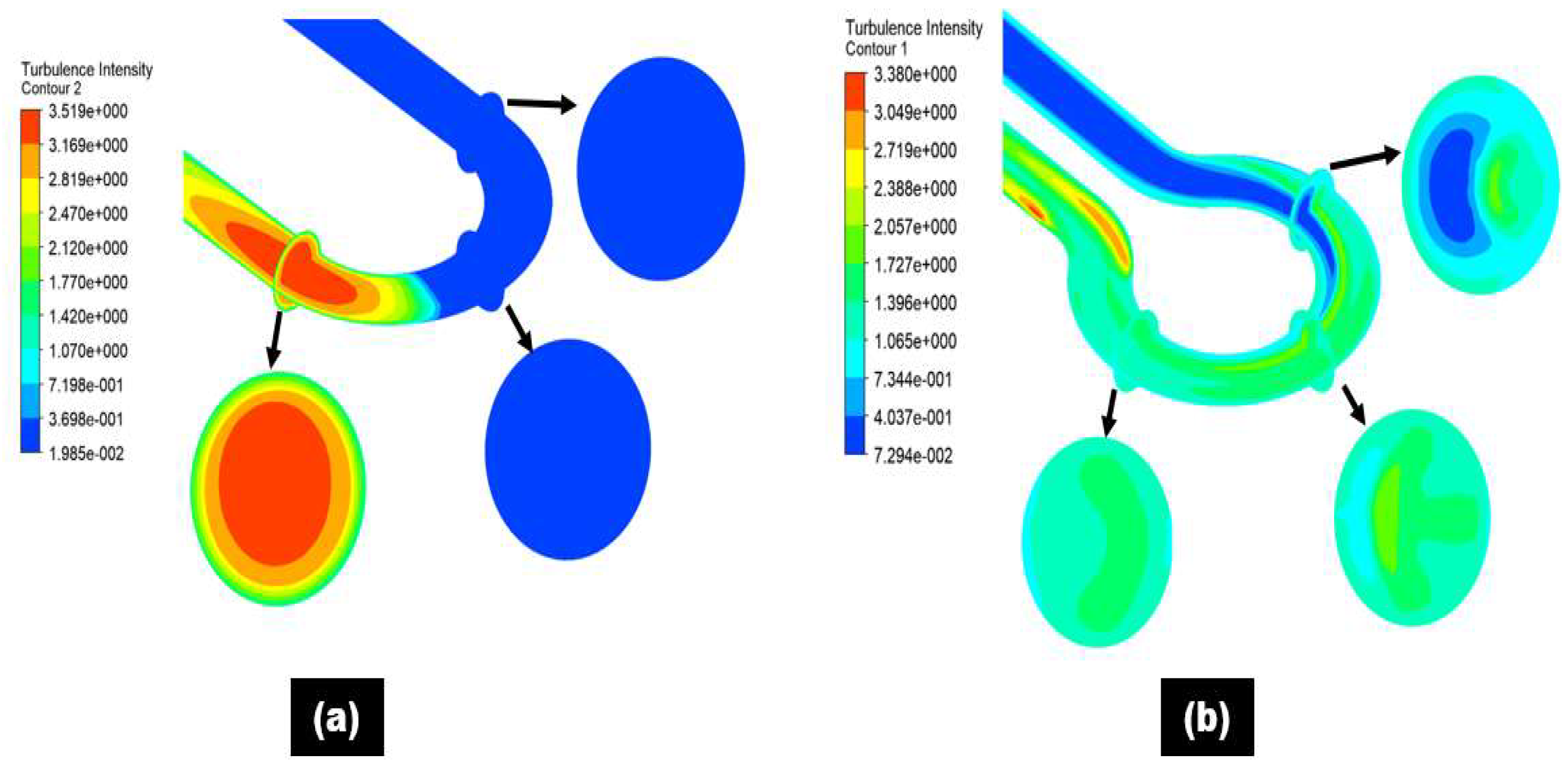
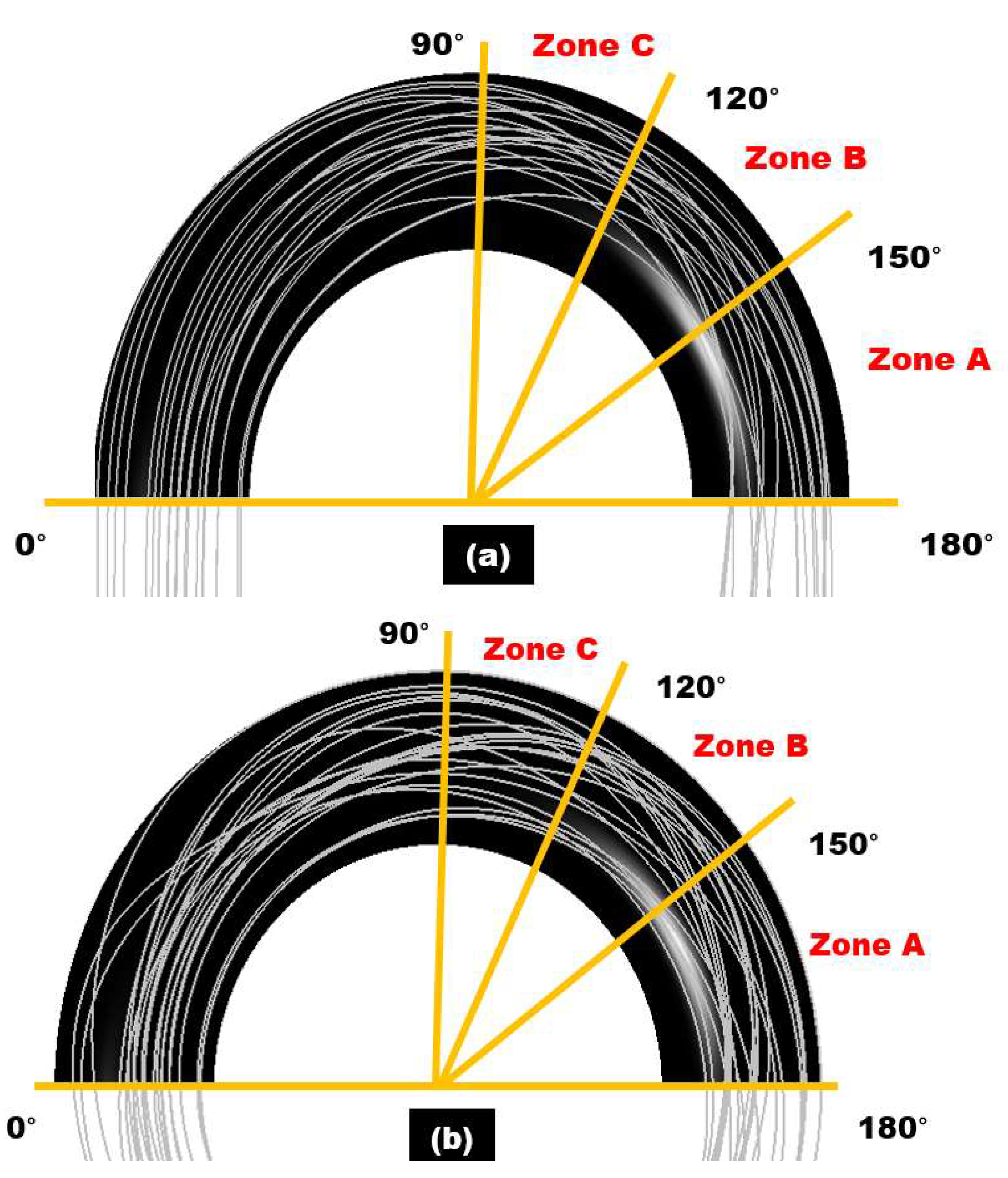
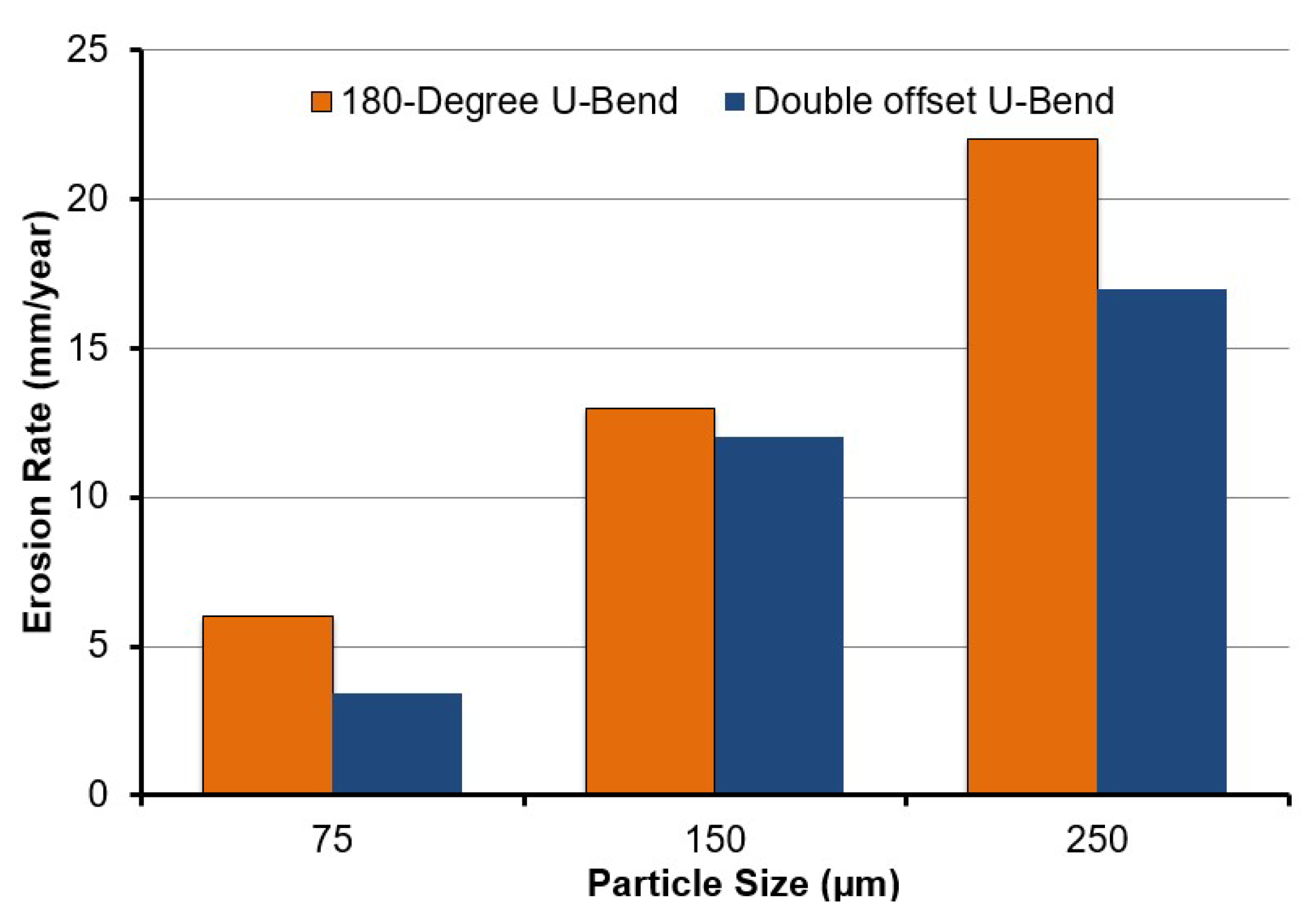
| Case | Fluid | Orientation | Sand Size (μm) | Bend Type | Flow Velocity (m/s) | Erodent Flow Rate (kg/s) |
|---|---|---|---|---|---|---|
| 1 | A | H–V upward | 300 | 180° | 45.72 | 1 |
| 2 | W | H–V upward | 200 | 180° | 10 | 0.2 |
| 3 | W | V-V | 450 | 180° | 2 | 0.3 |
| 4 | W | V-V | 450 | 180° | 4 | 0.3 |
| 5 | W | V-V | 450 | 180° | 6 | 0.3 |
| 6 | W | V-V | 450 | Double offset | 2 | 0.3 |
| 7 | W | V-V | 450 | Double offset | 4 | 0.3 |
| 8 | W | V-V | 450 | Double offset | 6 | 0.3 |
| 9 | W | V-V | 75 | 180° | 6 | 0.3 |
| 10 | W | V-V | 150 | 180° | 6 | 0.3 |
| 11 | W | V-V | 250 | 180° | 6 | 0.3 |
| 12 | W | V-V | 75 | Double offset | 6 | 0.3 |
| 13 | W | V-V | 150 | Double offset | 6 | 0.3 |
| 14 | W | V-V | 250 | Double offset | 6 | 0.3 |
Publisher’s Note: MDPI stays neutral with regard to jurisdictional claims in published maps and institutional affiliations. |
© 2022 by the authors. Licensee MDPI, Basel, Switzerland. This article is an open access article distributed under the terms and conditions of the Creative Commons Attribution (CC BY) license (https://creativecommons.org/licenses/by/4.0/).
Share and Cite
Rahman, S.; Khan, R.; Niazi, U.M.; Legutko, S.; Khan, M.A.; Ahmed, B.A.; Petrů, J.; Hajnyš, J.; Irfan, M. Performance Prediction of Erosive Wear of Steel for Two-Phase Flow in an Inverse U-Bend. Materials 2022, 15, 5558. https://doi.org/10.3390/ma15165558
Rahman S, Khan R, Niazi UM, Legutko S, Khan MA, Ahmed BA, Petrů J, Hajnyš J, Irfan M. Performance Prediction of Erosive Wear of Steel for Two-Phase Flow in an Inverse U-Bend. Materials. 2022; 15(16):5558. https://doi.org/10.3390/ma15165558
Chicago/Turabian StyleRahman, Saifur, Rehan Khan, Usama Muhammad Niazi, Stanislaw Legutko, Muhammad Ali Khan, Bilal Anjum Ahmed, Jana Petrů, Jiří Hajnyš, and Muhammad Irfan. 2022. "Performance Prediction of Erosive Wear of Steel for Two-Phase Flow in an Inverse U-Bend" Materials 15, no. 16: 5558. https://doi.org/10.3390/ma15165558
APA StyleRahman, S., Khan, R., Niazi, U. M., Legutko, S., Khan, M. A., Ahmed, B. A., Petrů, J., Hajnyš, J., & Irfan, M. (2022). Performance Prediction of Erosive Wear of Steel for Two-Phase Flow in an Inverse U-Bend. Materials, 15(16), 5558. https://doi.org/10.3390/ma15165558










